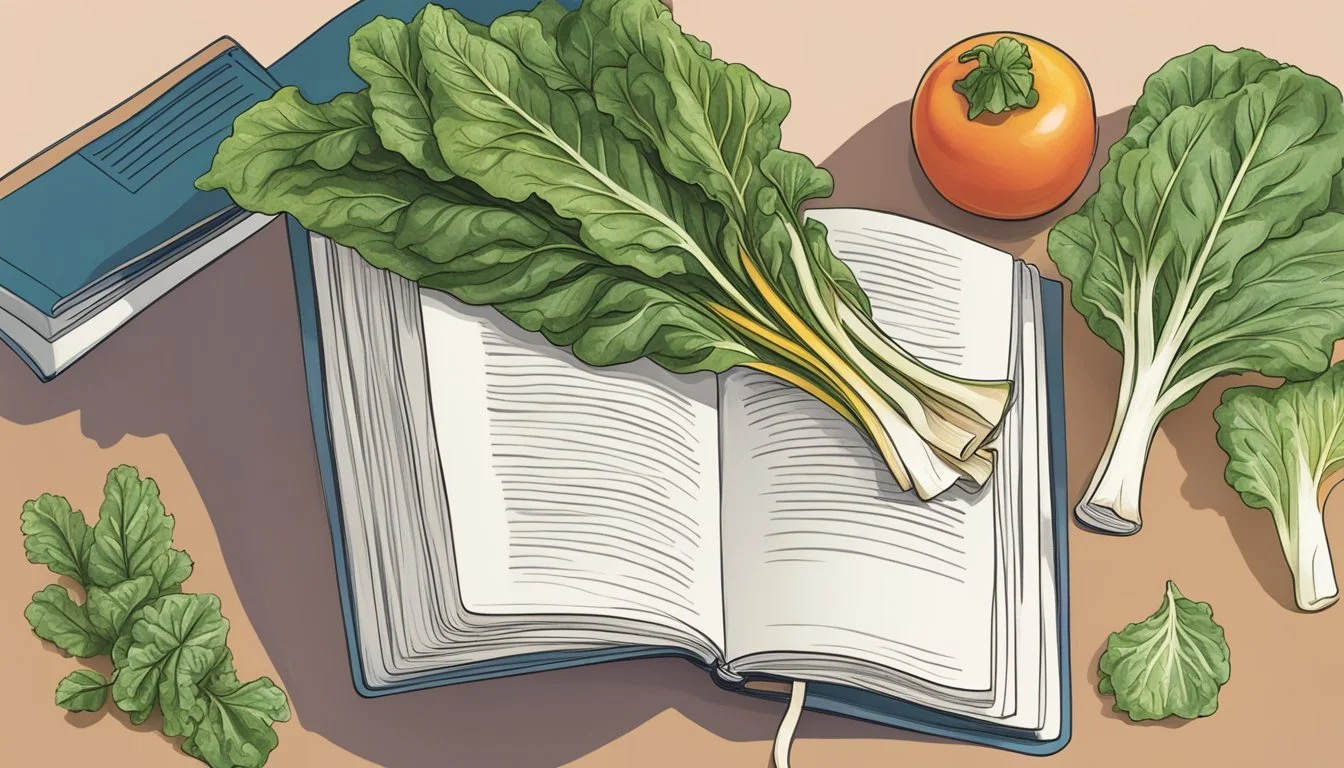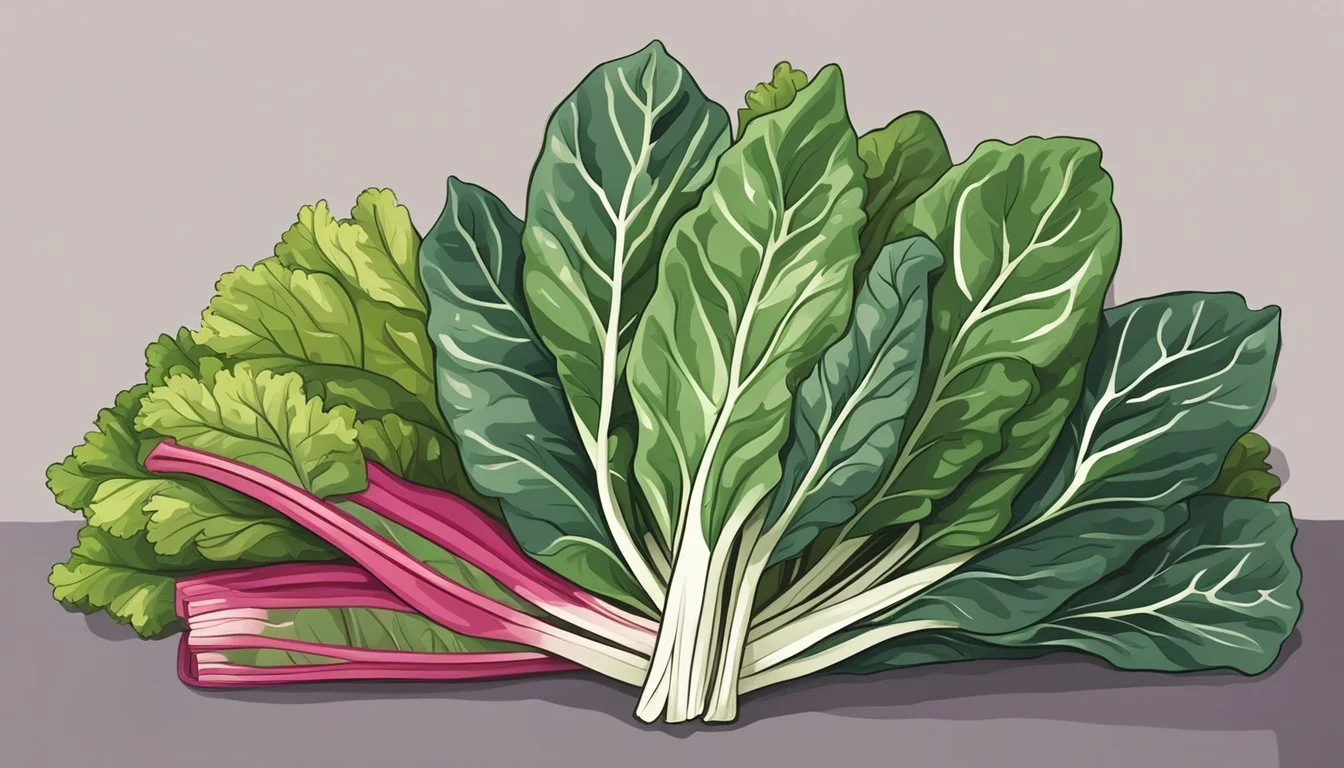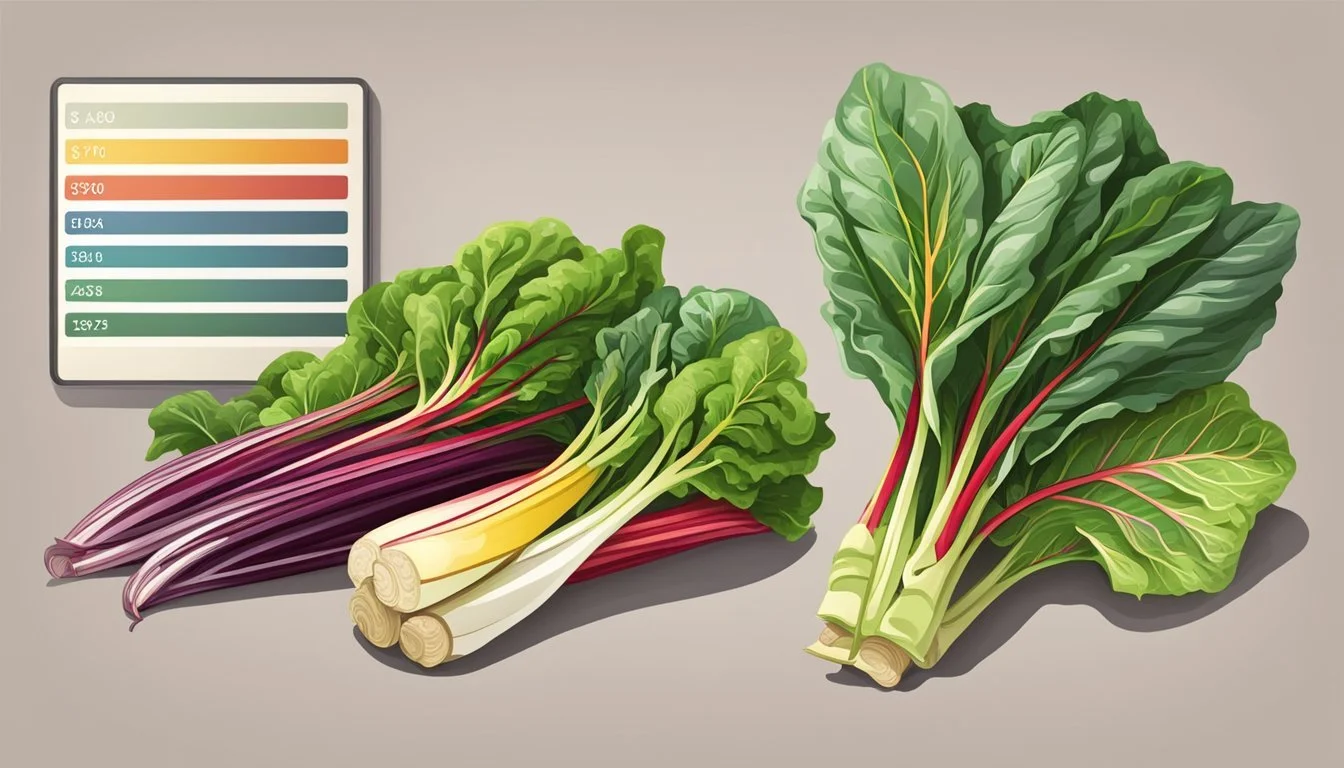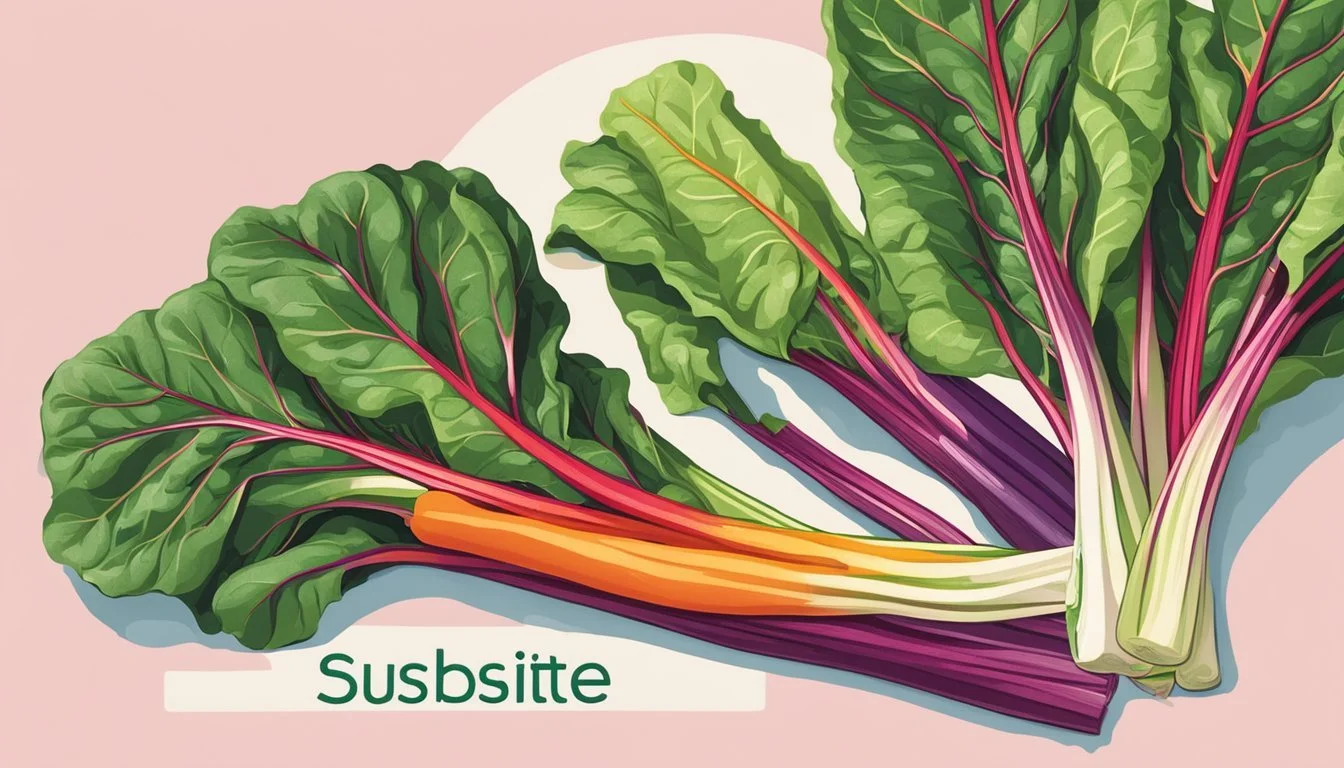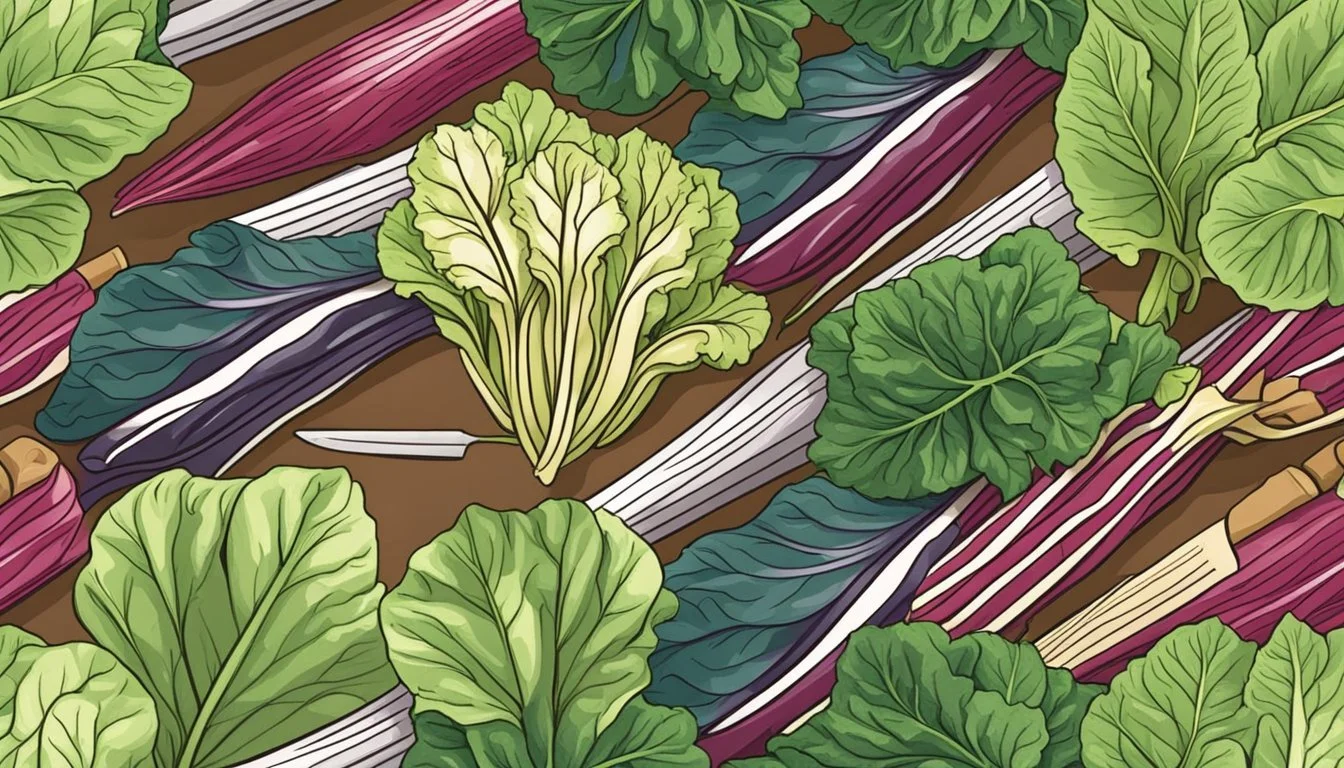How to Substitute Rainbow Chard for Swiss Chard
Easy Recipe Adaptations
Rainbow chard and Swiss chard are leafy greens that are often used interchangeably in recipes due to their similar flavors and textures. Both are members of the Beta vulgaris species and provide a multitude of vitamins and minerals, making them not only a versatile ingredient in the kitchen but also a nutritional powerhouse. Rainbow chard is so-called for its brightly colored stems which can range from red to yellow to white, whereas Swiss chard typically features white stems and a slightly stronger flavor.
When substituting rainbow chard for Swiss chard, cooks find that both varieties can be prepared in the same way, making the substitution straightforward. They can be sautéed, blanched, or used raw in salads and are excellent for adding color and nutrition to dishes. The stems of rainbow chard may require a few extra minutes of cooking time compared to the leaves to become tender, just as with Swiss chard.
The main difference to note when making the swap is the visual appeal that rainbow chard brings to the table. Its vibrant stems can enliven the presentation of a dish, which is particularly delightful in meals where aesthetics are as valued as taste and nutrition. Whether tossed into a stir-fry, baked into a gratin, or ribbons in a hearty soup, rainbow chard is a fitting substitute for Swiss chard in any recipe.
Understanding Chard Varieties
When exploring the culinary applications of chard, it's crucial to understand the differences between Swiss chard and Rainbow chard as they offer unique characteristics suitable for various dishes.
Swiss Chard
Swiss chard, a leafy green vegetable, is known for its bright-green leaves and contrasting white to pale green stalks. Although it is named 'Swiss' chard, its origin is not Switzerland; the etymology of its name remains a mystery. This chard variety is beloved for its mildly bitter taste when raw, which becomes more subtle upon cooking. Swiss chard is versatile and can be used interchangeably with Rainbow chard in recipes.
Key Characteristics of Swiss Chard:
Leaves: Dark green and slightly crinkled
Stalks: White to pale green
Taste: Mildly bitter when raw; sweetness emerges when cooked
Culinary Uses: Stir-fries, soups, stews (What wine goes well with stews?), and as a steamed or sautéed side dish
Rainbow Chard
Rainbow chard stands out with its vibrant, multi-colored stalks that span hues from red and pink to orange and yellow, with each color belonging to a different chard variety grouped together. Its leaves resemble those of green chard but are often adorned with veins that match the color of the stalks. Rainbow chard's flavor profile is similar to that of Swiss chard, making it a fitting substitute in any dish needing a splash of color.
Key Characteristics of Rainbow Chard:
Leaves: Dark green with colored veins
Stalks: Variety of colors including red, pink, orange, yellow
Taste: Comparable to Swiss chard; colorful stalks may have a slightly sweeter nuance
Culinary Uses: Ideal for adding color to dishes such as salads, pastas, or garnishes
Nutritional Comparison
When comparing Rainbow chard to Swiss chard, one finds that both are nutritionally dense leafy greens boasting a range of health benefits due to their vitamin and mineral content.
Health Benefits
Rainbow chard and Swiss chard share similar health benefits as they are both excellent sources of nutrients. These leafy greens are known for their potential in lowering blood pressure due to their high levels of potassium. They also contain antioxidants, which can contribute to overall health by combating oxidative stress.
Vitamins and Minerals
Looking into the specifics of their nutritional content, Rainbow chard and Swiss chard are both rich in vitamins A and C, essential for maintaining good vision, immune system health, and skin integrity. They are also a source of iron, critical for blood formation, and magnesium, which is necessary for numerous body processes.
Nutrient Rainbow Chard Swiss Chard Vitamin A High High Vitamin C High High Iron Good Good Magnesium Good Good Calcium Moderate Moderate Fiber Moderate Moderate Potassium High High
Both greens are quite comparable in calcium and fiber, contributing to bone health and digestive health, respectively. This nutritional comparison underscores that both Rainbow chard and Swiss chard contribute significantly to one's nutritional value and are interchangeable in diets that prioritize a variety of vitamins and minerals.
Culinary Uses
When substituting Rainbow chard for Swiss chard in cooking, it's essential to consider how the vibrant hues of Rainbow chard might affect the visual appeal of dishes and how its mild, slightly sweet taste can complement various ingredients.
Cooking Techniques
Rainbow chard is versatile and can be prepared using a range of techniques to suit different recipes. Leaves and stems can be sautéed to bring out a tender texture, making them a perfect component in stir-fries or as a side dish. For soups and stews, Rainbow chard can be chopped and added to impart a mild, earthy undertone. The robust leaves hold up well when sautéed or stewed, while the stems require a longer cooking time to tenderize. Rainbow chard can also be used raw in salads, providing a colorful and crunchy texture.
Technique Recommended Dishes Sautéed Stir-fries, Pasta dishes, Quiche Raw Salads Stewed Soups, Curries
Flavor Pairing
Rainbow chard features an earthy flavor paired with a mild bitterness, which allows it to blend well with a range of flavors. In soups and stews, it complements base ingredients like onions, garlic, and stock. A classic pairing involves beans or lentils, which balance the chard’s slight bitterness with their creamy texture. When used in a raw salad, nuts or sweet fruits like apple can contrast its earthy notes. Citrus dressings or vinegars often accompany Rainbow chard in dishes to cut through the bitterness, enhancing its natural sweetness. For stir-fries, Rainbow chard pairs well with bold ingredients like ginger and soy sauce to create a harmonious blend of flavors.
Bitter flavor: Balance with creamy or sweet elements.
Earthy flavor: Offset with acidic dressings or bold spices.
Substituting Rainbow Chard for Swiss Chard
When substituting rainbow chard for Swiss chard in recipes, it's important to consider the similar texture and flavor profile of both varieties. Rainbow chard offers a slightly sweeter note and vibrant colors that can enhance the visual appeal of the dish.
In Soups and Stews
In soups and stews, rainbow chard is a robust substitute for Swiss chard. Use it in equal amounts to add not only the earthy flavor you expect but also a splash of color. Add the rainbow chard towards the end of cooking to preserve its texture and color.
In Salads
Rainbow chard can be used raw in salads just as Swiss chard. For a substitute that maintains the integrity of the dish, chop rainbow chard leaves into bite-sized pieces and mix with other salad greens. Its vibrant stems will add a crunchy texture and a pop of color.
In Stir-Fries and Sautés
In stir-fries and sautés, rainbow chard makes an excellent substitute for Swiss chard. It wilts similarly and provides a comparable flavor. Remember to add the stems a few minutes before the leaves, as they take slightly longer to soften.
In Baked Dishes
When baked dishes call for Swiss chard, rainbow chard stands in well. Its leaves provide the same bulk and nutrients, while the colorful stems can create a more visually appealing dish. Again, use it in a one-to-one ratio, and consider adding the stems earlier than the leaves to ensure even cooking.
Alternative Substitutes for Swiss Chard
When Rainbow chard is unavailable, a variety of other leafy greens can be used to bring similar nutritional value and flavor profiles to dishes.
Using Other Leafy Greens
Leafy greens such as Kale (including Tuscan kale, dinosaur kale, and curly kale) and Collard Greens are excellent replacements for Swiss chard. They offer robust flavors and are packed with vitamins K and C. Mustard Greens and Beet Greens provide a peppery punch and are suitable in cooked applications. When using tougher greens like collards or kale, it's important to consider that their thicker, firmer leaves may require longer cooking times.
Kale (varieties): A nutritional powerhouse, known for its slightly bitter taste and firm texture.
Collard Greens: Similar in nutrition and cooking applications, but offer a milder flavor.
Mustard Greens: Pungent and spicy, best for someone looking for bold flavors.
Beet Greens: Tender and mildly sweet, closely resemble chard in both taste and texture.
Utilizing Spinach
Spinach is versatile and widely available, making it a popular substitute for Swiss chard. It comes in different forms, such as baby spinach with delicate leaves that are ideal for salads, and mature spinach which suits cooked dishes better. Spinach cooks down significantly and has a milder taste, so one might want to use more than the recipe calls for Swiss chard to achieve the desired flavor and bulk.
Baby Spinach: Soft and tender, requiring minimal cooking.
Mature Spinach: Has a more robust texture suitable for stews and sautés.
Always remember to wash leafy greens thoroughly before using, as dirt and grit can be lodged in their leaves. The suggested substitutes maintain the integrity of dishes where Swiss chard is called for, while delivering comparable nutritional benefits and flavors.
Selecting and Storing Chard
When choosing and storing various types of chard, such as rainbow or Swiss chard, one must be mindful of the freshness indicators and optimal storage tips to maintain its quality and flavor.
Freshness Indicators
Chard, in all its varieties, including rainbow, green, and red chard, should display vibrant, dark green leaves as a sign of freshness. The leaves should be tender, without any discoloration or wilting. For freshness verification, one should also inspect the stalks; they must be firm and crisp. White stalks signify a fresh batch of chard, often indicative of a just-harvested leaf.
Leaves: Look for dark green, tender leaves with no yellow spots.
Stalks: Ensure stalks are firm, indicating freshness.
Storage Tips
Proper storage of chard is essential for prolonging its shelf life and maintaining its nutritional value. To store, one should separate the leaves from the stalks and rinse any dirt and grit under cool, running water. After patting dry, wrap the stalks in a slightly damp paper towel or cloth.
Chard Storage Guide:
Wrapping: Enclose the chard in a damp paper towel or cloth.
Bagging: Store chard in an open or perforated plastic bag.
Location: Place the chard in the refrigerator's crisper drawer.
Following these guidelines, chard can remain fresh for approximately one week. It is generally best enjoyed shortly after purchase, but with proper storage, one can extend its crispness.
Preparation Techniques
When substituting rainbow chard for Swiss chard, chefs maintain similar preparation methods to ensure the greens maintain their vibrant colors and nutritional value. Here's how to prepare rainbow chard for a variety of dishes.
Cleaning Chard
Before chopping or cooking, chard must be thoroughly cleaned to remove dirt and grit. Leaves should be rinsed under cold water, and any tough parts of the stems trimmed away. One can immerse the leaves in a bowl of cold water, swishing them around to loosen any remaining dirt. Afterward, they should be lifted from the water, allowing the dirt to settle, and the process repeated if necessary. Spin the leaves dry in a salad spinner or pat them gently with a clean kitchen towel.
Chopping Chard
For chopping, chard leaves and stems should be handled separately due to their different textures. Leaves can be stacked, rolled tightly, and sliced into ribbons (chiffonade) for salads or more coarsely chopped for soups and stir-fries. Stems require a finer chop, given their sturdier structure, to ensure even cooking. For rainbow chard, cutting the stems on a diagonal can enhance the presentation of the dish with its colorful stalks.
Cooking Chard
Chard is versatile in cooking, adaptable to sautéing, steaming, or braising. For sautéing, heat olive oil in a pan over medium heat, add chopped garlic, and cook until fragrant before adding the chard stems first, followed by the leaves after a few minutes. They can be seasoned with salt, pepper, and a splash of lemon juice to brighten the flavors. The greens are done when they are wilted and tender, while the stems should have a slight crunch to retain their texture.
Frequently Asked Questions
Can rainbow chard be used as a substitute for Swiss chard?
Yes, one can use rainbow chard as a direct substitute for Swiss chard in recipes. They are essentially the same plant, differing only in the color of their stems.
Are the flavors of rainbow chard and Swiss chard different?
The taste between rainbow chard and Swiss chard is practically identical. Both have a slightly earthy flavor with a hint of bitterness.
What part of rainbow chard is edible?
Like Swiss chard, all parts of rainbow chard are edible. This includes the colorful stems, which can add a visually appealing element to dishes.
What are some good substitutes if neither Swiss chard nor rainbow chard is available?
Beet Greens: Closely related to chard, both rainbow and Swiss, and can be used similarly in recipes.
Amaranth Greens: These can work as a substitute, bearing a similar texture and flavor profile.
Perpetual Spinach: A type of leafy green that's not true spinach but has a comparable taste and use.
Seakale Beet: Also known as sea beet, it can substitute for chard in a pinch, though it may be harder to find.
Can the stems of rainbow chard be cooked the same way as Swiss chard stems?
Definitely. The stems of rainbow chard can be cooked just as Swiss chard stems — sautéed, boiled, or baked.
In terms of cooking time, keep in mind that thicker stems may require a bit more time to soften. It is often advised to start cooking the stems before the leaves, as they take longer to become tender.
Conclusion
In culinary applications, rainbow chard and Swiss chard are largely interchangeable. Rainbow chard, with its vibrant stems, offers a visually appealing alternative while maintaining similar flavor profiles and nutritional value. As a nutritional powerhouse, both varieties of chard are excellent sources of vitamins and minerals.
Garden enthusiasts may appreciate that rainbow chard can be grown with the same care as Swiss chard, thriving in well-draining soil and cooler temperatures. For those looking for a delicious and healthful addition to meals, incorporating rainbow chard can be a simple substitution.
Here's a quick reference guide for using rainbow chard:
Sauteing: Substitute in a one-to-one ratio with Swiss chard.
Raw Dishes: Rainbow chard's colorful stems add flair to salads.
Cooking Time: Treat it the same as Swiss chard; its robust leaves hold up well to heat.
Remember, the key to a seamless substitution is to consider the textural differences and cooking times which, for these two leafy greens, are minor. They can both contribute significant nutritional benefits and flavors to a variety of dishes, from stews and soups to stir-fries and salads.
For anyone seeking to diversify their palate or garden with a leafy green that is as nutritious as it is attractive, rainbow chard is a worthy candidate. Whether one is a chef tailoring their menu or a gardener curating their plot, the versatility of rainbow chard serves as a testament to its value in both the kitchen and the garden.

